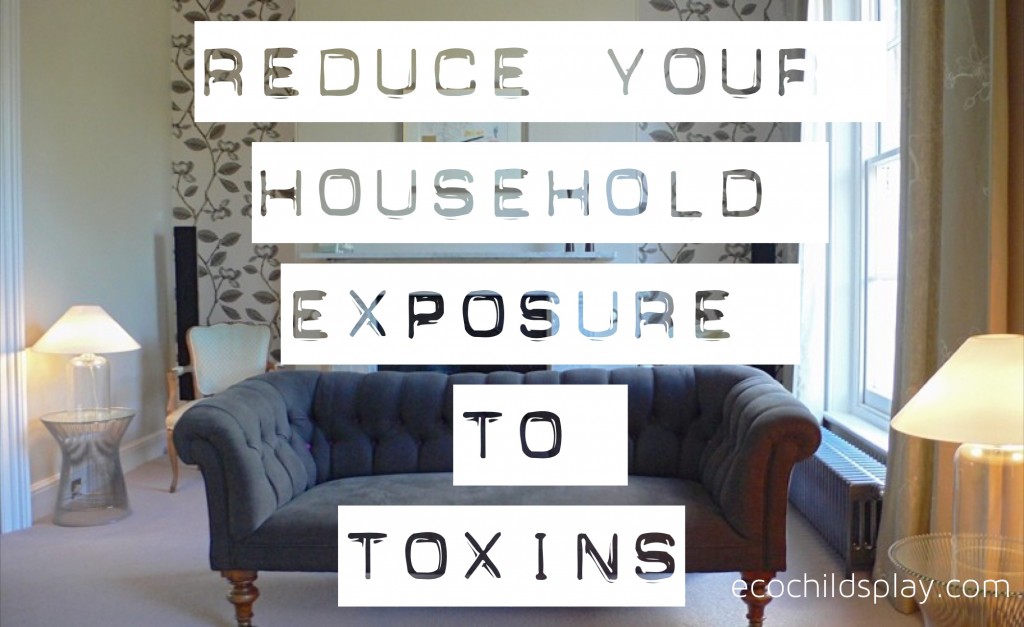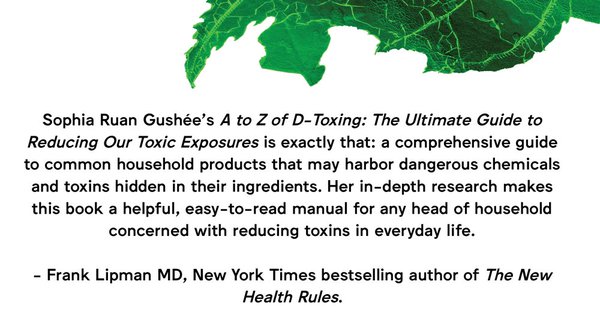 Detoxing has become quite a buzz word. Trends such as juice cleanses and colonic irrigation have gained popularity as people have become concerned with toxin accumulation in their bodies. The best and easiest way to detox, and the most scientifically proven, is to reduce your household exposure to toxins in the first place.
Detoxing has become quite a buzz word. Trends such as juice cleanses and colonic irrigation have gained popularity as people have become concerned with toxin accumulation in their bodies. The best and easiest way to detox, and the most scientifically proven, is to reduce your household exposure to toxins in the first place.In a study led by Mount Sinai School of Medicine in New York, in collaboration with the Environmental Working Group and Commonweal, researchers at two major laboratories found 167 chemicals, pollutants, and pesticides in the blood and urine of nine adult Americans. Study results appear in a recently-published edition of the journal Public Health Reports (Thornton, et al. 2002) – the first publicly available, comprehensive look at the chemical burden we carry in our bodies.
None of the nine volunteers work with chemicals on the job. All lead healthy lives. Yet the subjects contained an average of 91 compounds – most of which did not exist 75 years ago.
Our body burden
Scientists refer to the chemical exposure documented here as an individuals “body burden” – the consequence of lifelong exposure to industrial chemicals that are used in thousands of consumer products and linger as contaminants in air, water, food, and soil. There are hundreds of chemicals in drinking water, household air, dust, treated tap water and food. They come from household products like detergent, insulation, fabric treatments, cosmetics, paints, upholstery, computers and TVs, and they accumulate in fat, blood and organs, or are passed through the body in breast milk, urine, feces, sweat, semen, hair and nails. (Easton, et al. 2002, EPA 2002d, OECD 2002, Rudel, et al. 2001, Thornton, et al. 2000, USGS 2002).
We know that:
- U.S. chemical companies hold licenses to make 75,000 chemicals for commercial use. The federal government registers an average of 2,000 newly synthesized chemicals each year.
- The government has tallied 5,000 chemical ingredients in cosmetics; more than 3,200 chemicals added to food; 1,010 chemicals used in 11,700 consumer products; and 500 chemicals used as active ingredients in pesticides (EPA 1997c, EPA 2002b, EPA 2002c, FDA 2002a, FDA 2002b, FDA 2002c).
- In 1998 U.S. industries reported manufacturing 6.5 trillion pounds of 9,000 different chemicals (EPA 2001), and in 2000 major U.S. industries reported dumping 7.1 billion pounds of 650 industrial chemicals into our air and water (EPA 2002a).((http://www.ewg.org/sites/bodyburden1/findings.php))
According to the LA Times:
Virtually everything we buy, breathe, drink and eat contains traces of toxic substances…Every day, about half a dozen chemicals are added to the estimated 83,000 already in commerce. In the United States alone, about 42 billion pounds of chemicals are produced or imported daily.
How to reduce your household exposure to toxins
Health-conscious mother of three, Sophia Ruan Gushée thought she knew how to be healthy. Only after she became a mother did she become aware of an overlooked influence on health: toxic exposures. These pervade not just our outdoor environments but also our homes, bodies, and diet. Their impact on health can be most influential during periods of rapid biological development, which makes protecting children a top priority.
Inspired to become a truly conscious parent and to provide her young family with a healthy foundation, Sophia spent more than five years identifying practical approaches for reducing her family’s unnecessary exposures. In A to Z of D-Toxing: The Ultimate Guide to Reducing Our Toxic Exposures, Sophia shares what she learned.
Created to be the only reference book that a head of household needs, it includes hundreds of tips, as well as ten ideas to implement today–Sophia’s D-Tox Strategy. These tips help increase the odds for more resilient health not just for individuals, but for our planet as well. This is an empowering resource that will lay the groundwork for leading a healthy life.
 A to Z of D-Toxing: The Ultimate Guide to Reducing Our Toxic Exposures is a comprehensive reference book. It is a book to be referred to often, as you make decisions for your family. It is not a cover-to-cover read.
A to Z of D-Toxing: The Ultimate Guide to Reducing Our Toxic Exposures is a comprehensive reference book. It is a book to be referred to often, as you make decisions for your family. It is not a cover-to-cover read.- Improve indoor air quality
- Fight the dust
- Wash your hands often
- Listen to your body
- Detox what you put on your skin
- Let food be thy medicine
- Edit your possessions
- Ensure Restorative Rest
- Engage
- Don’t strive for perfection
These are all strategies we have advocated in blog posts over the last nine years. Sophia compiles information and backs it up with research and depth. This is one resource that everyone should have in their home. It will remain on my coffee table as I continue to learn how to reduce our household exposure to toxins
The amount of chemicals we are exposed to is astounding. Being informed is the first step to reducing your household exposure to toxins. This information can then be carried to the workplace and school environment.
Reducing household exposure to toxins is much easier and effective than jumping on the detox bandwagon. The changes will be generational rather than individually for a month or two. I highly recommend A to Z of D-Toxing: The Ultimate Guide to Reducing Our Toxic Exposures!


Leave a Reply